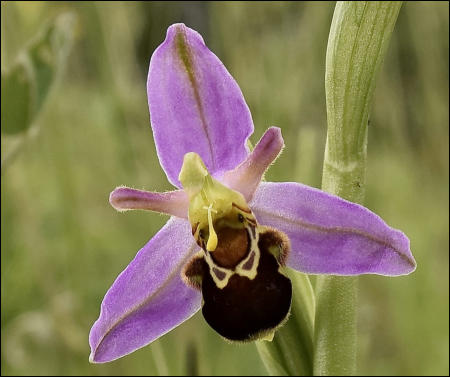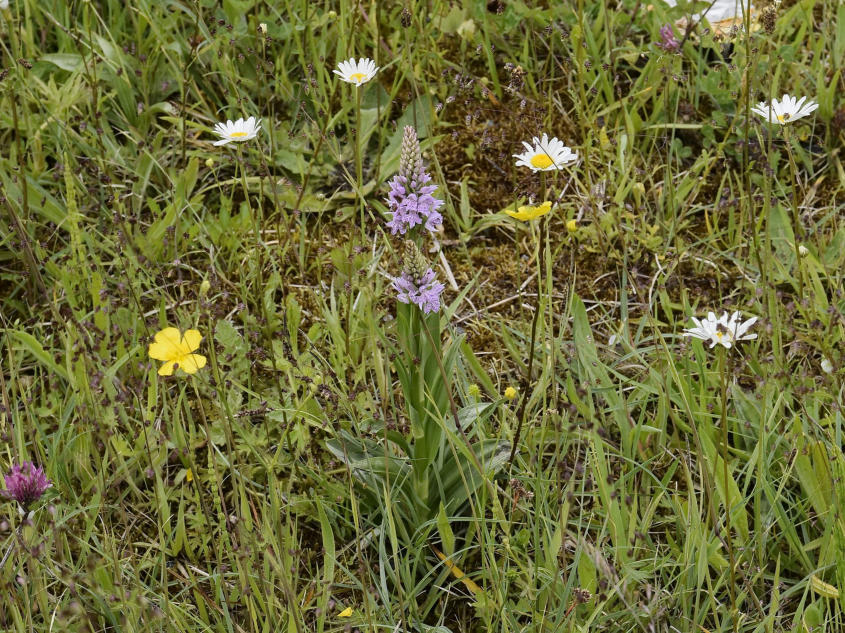




N4 Roadside Orchids:
A few kilometres from Carrick on Shannon, a small colony of Bee Orchids is located on the grass margin of the busy N4 heading towards Boyle. Numbers were fairly good earlier in June however Council cutting of vegetation (to enable clear view on either side of a nearby junction) have also destroyed orchids from a part of the site. However, there are still a few in the uncut section of the roadside and these are are flowering well (June 15th). We often associate Bee Orchids with sand dunes, at places like Strandhill in Co Sligo, so it is great to see them locally!
Click on Images where you see this symbol.
1400px
Local Orchids, East
Bee and Birdsnest Orchids
June 20, 2021
site
Looking east towards Lough Key and Lough Arrow we see a couple of beautiful Woods —
Lough Key Forest Park and Drumharlow Woodand. Lough Arrow is known for a dwindling
but loyal population (5?) of Common Scoter, a sea duck that breeds in inland moors lakes and
ponds but is now getting very rare in Ireland — except in Winter when there are thousands to
be seen off our shores.
In the Summer these lakes and associated parklands support a diverse and abundant array of
orchids, not to mention big trees and a wide variety of plants such as Ferns, Yellow Loosestrife,
Bluebells, and other waterside species. Also in early Spring large numbers of Toothwort can be
found around decaying Beech Trees and the exotic and unusual White Saddle fungus.
BELOW; Bee Orchids (Ophrys apifera) on the grassy margin of the N4 near Drumharlow, Carrick on Shannon
The Bee Orchids were scattered among the grass and other
vegetation inside the hard shoulder of the N4 near the Drumharlow
lake turn-off. Traffic is quite busy here so we parked on a small road
which leads off the N4 and walked back along the grass. Many of the
orchids seen were Common Spotted just coming into flower, but
here and there — often well camouflaged by Horsetails, Buttercups
or Trefoil — were six or seven Bee Orchids. Most had one or two
flowers open, with four or five buds developing.
The images (L and R) show close ups of Bee Orchid flowers. These
are from different plants and clearly show the pollinia as the little
yellow balls at the top of the flower. Pollinia either drop into the
flower to fertilise it, or are carried by insects to another flower.
These pollinia are first tucked away in a channel at the top of the
flower as in the image directly ABOVE. (Click to enlarge.) As they
develop, they drop down on long flexible stalks over the front of the
flower (LEFT) where they can stick onto the back of a visiting insect.
On the image to the RIGHT, one of the pollinia has been detached,
possibly by an insect, but maybe has just fallen into the flower to
pollinate it. Both methods of fertilisation work, making this a much
more successful species than the similar Fly Orchid with a
significantly different reproductive philosophy!.

Drumharlow Lake
Drumharlow Lake is located on the Boyle River just above the junction with the river Shannon. It was previously called Lough Eidin (and locally often called that still) after Saint Eidin, who built her convent on the shores of the lake in the 8th century. She is the patron saint of the Tumna parish, Carrick on Shannon, and a wooden sculpture to the saint has recently been erected on the edge of the river in Carrick on Shannon. It is an interesting lake, well favoured by fishermen, and the mixed woodlands around the shores are a good place to find hundreds of Early Purple Orchid — the first orchid to appear in the springtime — Early Marsh orchids and also the much rarer Birdsnest Orchid, Neottis nidi-avis. However, this year Birdsnest Orchids were few in number in these woods — perhaps due to the very wet Spring weather? Just two were seen on May 1st, and five on June 15th.
Lough Key Forest Park
Initially numbers of Birdsnest Orchids seen at Drumharlow and L. Key were minimal as everywhere. Lough Key Forest Park, just a few kilometres further
along the N4, eventually had excellent numbers of this orchid with some stunning plants. Lough Key is a fascinating place, host to many orchids and
other interesting plants. The Park has a Visitor area, and Camping site with all the usual facilities, but much of the Park is left untended with wild
woodlands, boggy areas, and little hills to explore. In quiet areas there are many small paths just used by deer and other wildlife, plus the occasional
botanist or dog walker…
Also May 1st 2021, a slightly more developed Birdsnest orchid
One of two Birdsnest orchids seen on May 1st, just in bud
Close up of Birdsnest orchid flowerhead, June 15th
One of the 5 Birdsnest orchids seen on June 15th
Pollinia hanging from rostrum in front of the labellum —like a lure!
One of our pollinia is missing!
We have found Birdsnest Orchids in two particular locations in the Forest Park, one being beside the ‘dual carriageway’ near the first
parking spot in the Park, the other being halfway around Drummans Island. In total, there were probably over 60 - 100 in the both
locations this year.
At this time of year it is quite dark under the trees where these orchids grow, so a flash was needed. But, being orchids that do not
photosynthesise and have no green chlorophyll, they have little competition from other plants in these dark areas! The flash does
highlight the unusual colour and features of the Birdsnest Orchid and it looks rather eerie… The orchids here were very strong and sturdy,
with little evidence of damage from slugs or insect larvae. There are probably other places within the Park where these orchids may be
found; do let us know if you do see them!
.

















A fine, though rather ghostly specimen, to finish the page. But why are they called
Birdsnest orchids?
Click on image to see flower in detail, with its two-pronged Lip.
Keep an eye out for these orchids when you are walking in Lough Key Forest Park in May and June!

Roadside Biodiversity
Orchids on roadsides are a wonderful part of our biodiversity; the orchids like limestone (both from the local soil and the road chips), no fertilisers are used here, and plants can thrive. But roadsides like this are important for other plants as well; In the image LEFT you can see a couple of Common Spotted Orchids, these ones being a lovely pale lilac shade — Common Spotted orchids come in many colours varying from pink to purple and even white. Also in this little stretch are Ox-Eye daisies (or Marguerites as they used to be called), Buttercups, Quaking grass, Clover, Horsetails, sedges and mosses, and many other plants which have yet to flower. If roadside margins can be left undisturbed as much as possible (or as much as is safe for road users) we can preserve many of these wild plants which are disappearing from land that is fertilised, or areas that are being planted with coniferous forests. In some other countries, sections of roadside where rare plants occur are protected and left uncut, and are termed ‘’Roadside Nature Reserves”.





